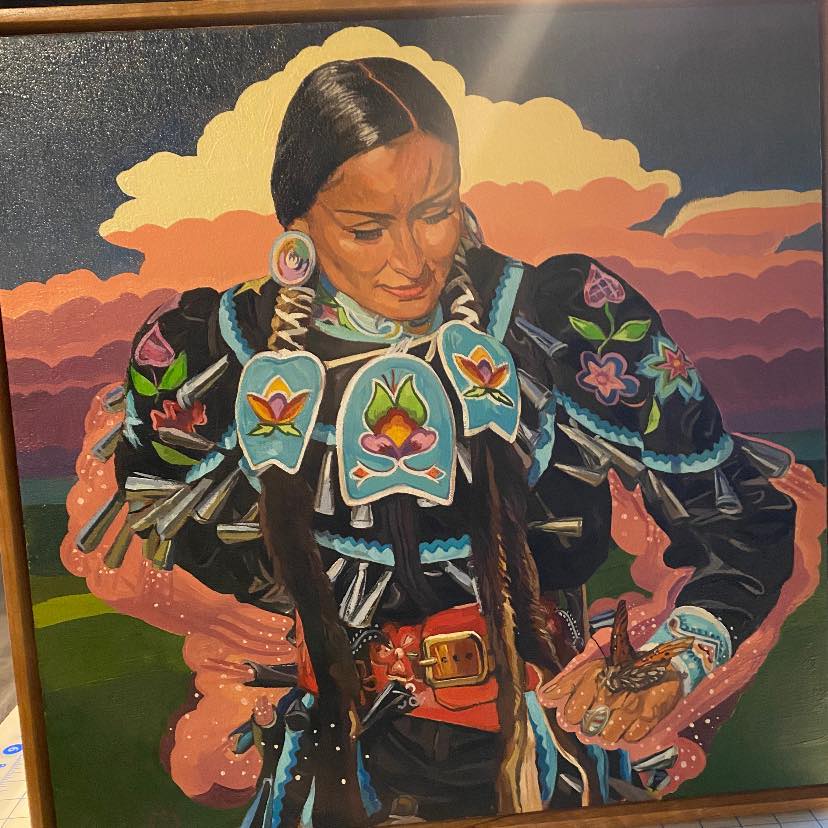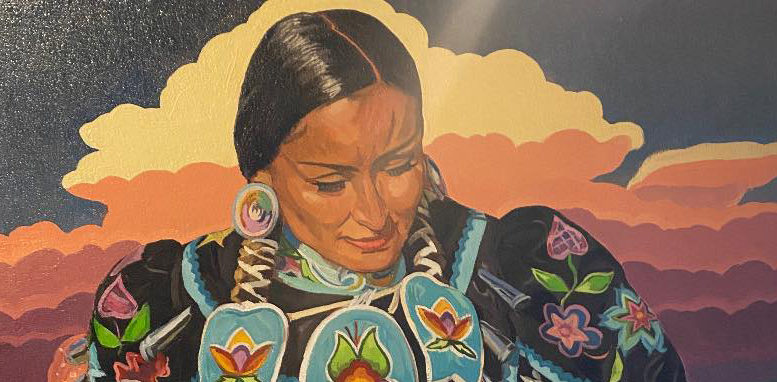by Chevi Rabbit, Local Journalism Initiative Reporter
(ANNews) – Leah Omeasoo-Gillette is a member of Samson Cree Nation, one of four reserves that make up Maskwacis, AB. She is an educator in her community with a Bachelor of Education degree and is currently a Master of Education student at the University of Alberta. In addition, she is a well-known jingle dress dancer who has been crafting her dance since she was two years old.
Leah Omeasoo-Gillette comes from a prominent powwow family that has significantly contributed to the powwow culture. She is the daughter of Steve Wood and Hilda Omeasoo-Wood. Leah’s father, Steve Wood, 60, is the founder and drum keeper of the Northern Cree Singers, and the group has received 9 Grammy nominations.

Painting of Jingle Dress Dancer Leah Omeasoo-Gillette. Photo by Jason Dial. Painting by Isaiah Stewart.
At age six, Leah started dancing to a contemporary jingle dress. She successfully harnessed skills as a contemporary jingle dress dancer, and her dedication got her noticed within the powwow community.
In 2007, everything changed for Leah as she learned a new style of the jingle dress, commonly referred to as “old style” jingle dress dancing.
After attending a traditional powwow in Ontario and witnessing a jingle dress ceremony, she decided to start dancing to the older style of the jingle dress. Her first-time dancing “old style” jingle was at the Veterans powwow hosted at the Panel Memorial Agriplex in Maskwacis, AB.
Leah says the feedback from the elders in her community encouraged her to continue dancing this style.
“There are differences between the foot systems and how the dancers present themselves with their outfits,” she explained. “Contemporary regalia are very colourful, shiny, and flashy.
“They wear plumes and eagle feathers, while the older style of jingle dress is toned down and simple.
“The women keep their feet closer to the ground, and the steps are simple. The women do not carry or wear feathers.”
She incorporates sweetgrass, velvet, and beadwork in her work and dresses.
Leah says that from her understanding, the Jingle Dress is originally from the Ojibwe people of Ontario, parts of Manitoba, Minnesota, and Wisconsin and that each area has its unique variation to the origins of the dance. Still, one thing that remains consistent in the dance is healing and strength.
According to faculty research at the University of Minnesota, the Ojibwe people believe in the healing power of music and the jingles. They believe that spiritual power moves through the air. If you’ve ever been to a powwow, you’ve heard dozens of women dancing together in jingle dresses; it makes an incredible sound. The sound of the tinkling of jingle dresses is part of healing and it is very much in line with how Ojibwe people view the world and how they view spiritual power.
“The great thing about being a part of the powwow community is that everyone is supportive and makes significant long-lasting friendships,” said Leah.
She comes from a traditional family where practicing culture is very important. “This is our life,” she said. “This is how we were raised, and I wouldn’t have it any other way. I’m grateful to my parents for raising me in the powwow circle.”
Leah aims to cultivate and raise her family in the powwow community and carry the family tradition.
She shared a compelling moment in her life when she was selected to be the 2011 Head Lady dancer at the Gathering of Nations in Albuquerque, New Mexico. For those unaware of this gathering, it is one of North America’s largest and most recognizable powwows and has been going on for 39 years in New Mexico.
Leah’s love for the powwow culture reminds us that it’s important to be proud to be First Nations and that we have a rich culture with welcoming ceremonies.
Her message to the youth is: “Learn your language and culture because these two powerful strengths will lead and guide you through life. If you would like to know more about dancing or your culture, reach out to a dancer or singer and ask questions. There is help all around, just ask.”
“Everyone is welcome to join the powwow circle,” she added. “Come out and join us in celebration of song and dance.”



Be the first to comment on "Leah Omeasoo: The healing power of jingle dress dancing"